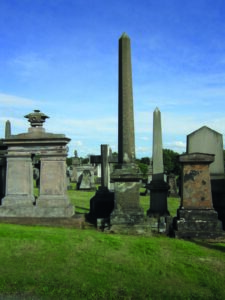James Buchanan Mirrlees (1822-1903)
By Colin Campbell and Morag T Fyfe
Born in Glasgow on 19th August 1822 to William Mirrlees, a saddler and Elizabeth Buchanan, James was their fourth child and one of at least eight children.
James almost certainly attended the Grammar School and he certainly matriculated at the University of Glasgow in 1838 but there is no record of him having graduated. On the other hand his son William Julius Mirrlees graduated BSc in 1882.
His subsequent career was spent in mechanical engineering, specialising initially in the production of machinery for sugar processing in which Glasgow was becoming a world centre and later in the century in the production of diesel engines.
In 1848 he joined the firm of P&W McOnie which after several name is best known as Mirrlees, Watson Company Ltd. By 1876, the company had grown to employ a workforce of around 800 and had one of the most fully equipped workshops in Britain at Scotland Street, Glasgow. The years 1878-1884 saw a boom in the sugar machine manufacturing industry and saw the company produce 45,000 tons of machinery, worth about £1,500,000. Up to the year 1885 the output of the works consisted almost exclusively of machinery for the production, manufacture, and refining of sugar, of which they were the largest manufacturers in the country, and had a world-wide reputation. Since then the industry began to decline and the company turned their attention to other branches of engineering. In 1897 an agreement was signed whereby Dr Rudolf Diesel granted the company an exclusive licence for the manufacture and sale of diesel engines in Great Britain. Following this agreement, the first engine was completed in November 1897. This was the third diesel engine in the world. After initial problems, diesel engine manufacture took off but J B Mirrlees had retired from the company in 1898 and it was his successors who developed this new line.
Away from business life, James was active in civic affairs being variously a town councillor (1862-1868) and Lord Dean of Guild of the Merchants House (1879-1881); he had obtained his Burgess Ticket in 1862 as a Hammerman as a younger son of his father. He was also a director of the Clydesdale Bank, and sat on the boards of commercial companies.
James married twice, firstly to Williamina Nicol Fleming in 1849; she died at Shandon Cottage, Gareloch in 1853 aged 26 leaving two daughters. She is commemorated on the gravestone in the Necropolis but is not buried there. Six years later James married Helen Gumprecht who outlived him dying in 1928. In all he had ten children, four boys and six girls.
He built an Italianate villa, Redlands House, on a plot of 24 acres on Great Western Road in 1870. In 1922 Redlands was converted to house Glasgow Women’s Private Hospital which was looking for new premises. Later known as Redlands Hospital for Women it closed in 1978 and after a spell as an ambulance staff training centre, was converted into flats.
James Buchanan Mirrlees died at Redlands House on 16 November 1903 and was buried in Compartment Omega in the Necropolis on 19 November. A son and a daughter who predeceased him are also buried there. The initial value of his estate was recorded as £165,607 6s 7d.
(Sources: Graces Guide, ScotlandsPeople, The Glasgow Story, GU Archives, Workshop of the British Empire by Michael S Moss and John R Hume)










